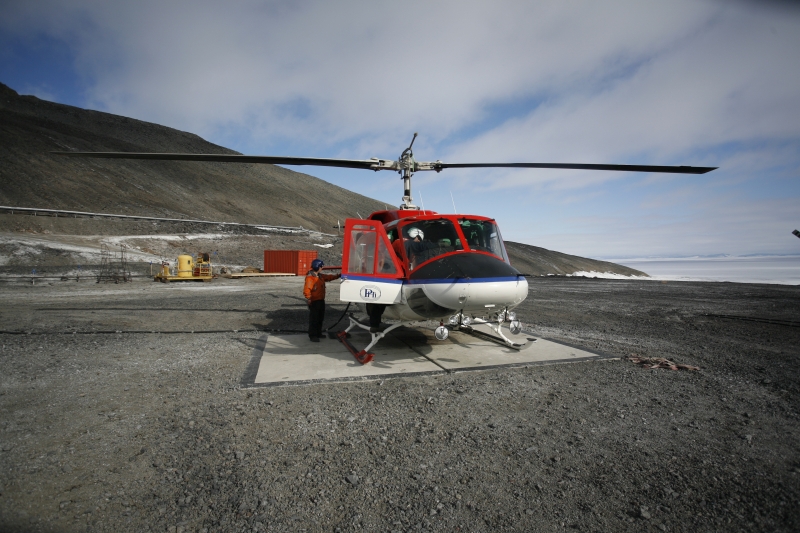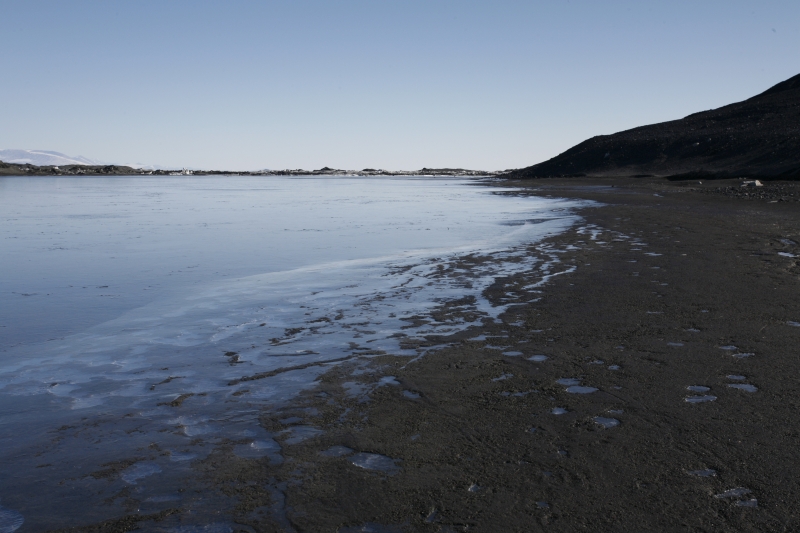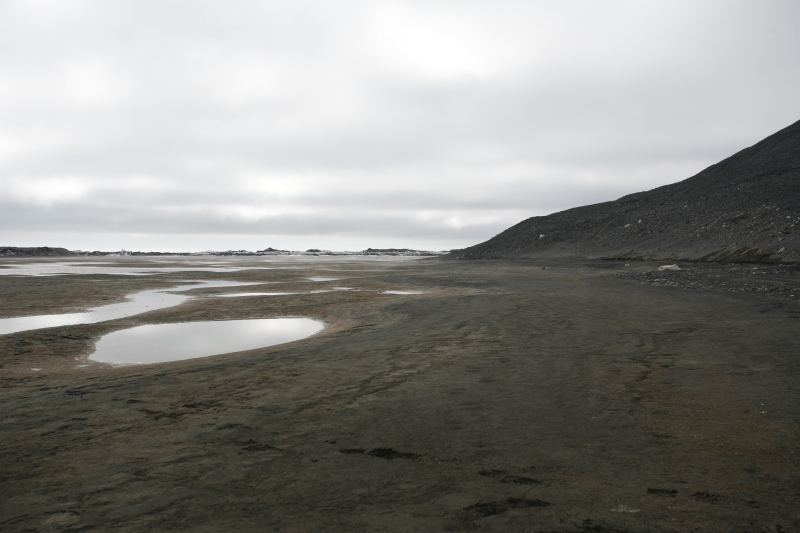1-18-06 Bratina Island
A second update for the 18th of January. Yesterday I got to tag
along on a class trip to Bratina Island, which is southwest of
McMurdo Station across McMurdo sound. Bratina Island is a true
island surrounded by the Ross Ice Shelf, which is pushing up
against the island and all the way around it. The ice shelf here
has a very rough surface due to uplift and cracking and the
pressure ridges that form. The ice shelf is also topped with a
layer of dirt that was scraped up off the sea floor hundreds
of years ago and has moved up through the ice as the top layers of
ice evaporated off the top. The dirt and rocks are left behind on
the surface of the ice shelf, and they form a set of low hills in
which many hundreds of ponds form. These ponds are formed by water
collecting inlow areas, and the ponds vary widely in their
composition. Some are freshwater ponds, some are slightly salty,
and some ponds are extremely salty, over 100 parts per thousand,
compared to the ocean's normal value of around 30 ppt.
We traveled to Bratina by helicopter, which is the normal mode of travel across the ice for the field sites which are far away from McMurdo Station. The helicopter ride took about 10 minutes.

The landing pad at Bratina is a primitive circle of rocks in the dirt. There are three small huts and a porta-john on the island, all set hereby the Kiwis for their research program. The porta-john is locked, and we are not allowed to go to the bathroom anywhere on the ground, so that we do not disturb the delicate pond system. Instead, everyone brings a bottle to do their business in, and you carry your bottle back toMcMurdo with you.

Bratina includes a set of tidally influenced ponds that have the water rise and fall up to a meter every day. This is the beach at high tide. The water along the shore and in the footprints is all frozen in a thin sheet which cracks and falls apart as the tide drops.

Here is the same beach at low tide later in the day. The ice has all melted and all that is left are several individual pools in the depressions.

To get to the pond system on the ice shelf you need to leave the island and cross this crack onto the shelf. The legend is that this crack falls more than fifty feet straight down to the bottom of the ice shelf. No one fell in today.

The interest in Bratina has to do with this extensive pond system. Pictured below is a set of three ponds sitting right next to each otherthat have vastly different water types. The pond the right side is a freshwater pond, the pond in the back left is a brackish pond, and the small pond in the foreground on the right is a hypersaline pond. You can see the white crust of salt crystals surrounding the salt pond.

Some of the ponds had a thick layer of ice on top, some were unfrozen,and some ponds had a paper-thin sheet of ice on them that you could easily sea through. The oil slick of colors on this pond are from the layer of ice floating on top of it. You'll notice the orangish tint ofthe sediment around the edges of this pond. All of that is aconglomeration of many different bacteria that are growing in thick mats on the sediment. People come here to study the make up this microbial mat community, and to compare the communities among the different ponds.

The microbial mats can grow very thick over long time periods, and continuing ice movement under the surface can lift them up out of the ponds. In the picture below is a layer of microbial mats several inches thick.

The only real wildlife we saw at Bratina were a few Skua birds. These things are like seagulls, but even more aggressive. They will defend their nesting territory from other Skuas and from humans who trample by.

The skuas came down to investigate our activities and to see if we might drop any food. I caught a picture of this skua wandering around on theice surface of a pond. They are rather awkward on the ice, as you can see by this bird's splayed legs.

I mentioned the movement of dirt and rock from under the ice sheet up to the surface. Included in this transport are the occasional sea creatures which get picked up by the ice. Many years later they emerge on the surface, and we found a sea sponge at the top of a small hill as proof of this process.

Here is a close up shot of the sponge. It is fairly degraded, but you can still pull apart the spicules that make up the body of the organism. Spicules are extremely hard to degrade, so they will be around for avery long time.

To close this out, I've been notified that Heather Archie and the rest of Ms Ewert's 5th grade class from Cubberly Elementary School are checking in here occasionally. Here is your official "Hello!" from the bottom of the earth. If you have any special requests, you can drop me a line on email and I'll see what I can do to fulfill it.
We traveled to Bratina by helicopter, which is the normal mode of travel across the ice for the field sites which are far away from McMurdo Station. The helicopter ride took about 10 minutes.

The landing pad at Bratina is a primitive circle of rocks in the dirt. There are three small huts and a porta-john on the island, all set hereby the Kiwis for their research program. The porta-john is locked, and we are not allowed to go to the bathroom anywhere on the ground, so that we do not disturb the delicate pond system. Instead, everyone brings a bottle to do their business in, and you carry your bottle back toMcMurdo with you.

Bratina includes a set of tidally influenced ponds that have the water rise and fall up to a meter every day. This is the beach at high tide. The water along the shore and in the footprints is all frozen in a thin sheet which cracks and falls apart as the tide drops.

Here is the same beach at low tide later in the day. The ice has all melted and all that is left are several individual pools in the depressions.

To get to the pond system on the ice shelf you need to leave the island and cross this crack onto the shelf. The legend is that this crack falls more than fifty feet straight down to the bottom of the ice shelf. No one fell in today.

The interest in Bratina has to do with this extensive pond system. Pictured below is a set of three ponds sitting right next to each otherthat have vastly different water types. The pond the right side is a freshwater pond, the pond in the back left is a brackish pond, and the small pond in the foreground on the right is a hypersaline pond. You can see the white crust of salt crystals surrounding the salt pond.

Some of the ponds had a thick layer of ice on top, some were unfrozen,and some ponds had a paper-thin sheet of ice on them that you could easily sea through. The oil slick of colors on this pond are from the layer of ice floating on top of it. You'll notice the orangish tint ofthe sediment around the edges of this pond. All of that is aconglomeration of many different bacteria that are growing in thick mats on the sediment. People come here to study the make up this microbial mat community, and to compare the communities among the different ponds.

The microbial mats can grow very thick over long time periods, and continuing ice movement under the surface can lift them up out of the ponds. In the picture below is a layer of microbial mats several inches thick.

The only real wildlife we saw at Bratina were a few Skua birds. These things are like seagulls, but even more aggressive. They will defend their nesting territory from other Skuas and from humans who trample by.

The skuas came down to investigate our activities and to see if we might drop any food. I caught a picture of this skua wandering around on theice surface of a pond. They are rather awkward on the ice, as you can see by this bird's splayed legs.

I mentioned the movement of dirt and rock from under the ice sheet up to the surface. Included in this transport are the occasional sea creatures which get picked up by the ice. Many years later they emerge on the surface, and we found a sea sponge at the top of a small hill as proof of this process.

Here is a close up shot of the sponge. It is fairly degraded, but you can still pull apart the spicules that make up the body of the organism. Spicules are extremely hard to degrade, so they will be around for avery long time.

To close this out, I've been notified that Heather Archie and the rest of Ms Ewert's 5th grade class from Cubberly Elementary School are checking in here occasionally. Here is your official "Hello!" from the bottom of the earth. If you have any special requests, you can drop me a line on email and I'll see what I can do to fulfill it.

<< Home